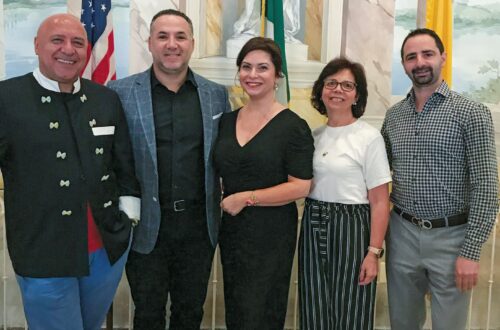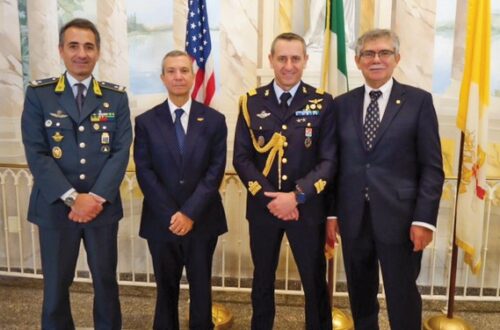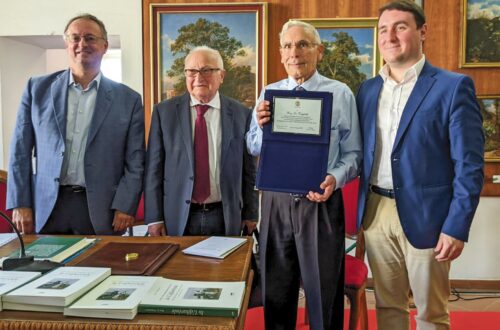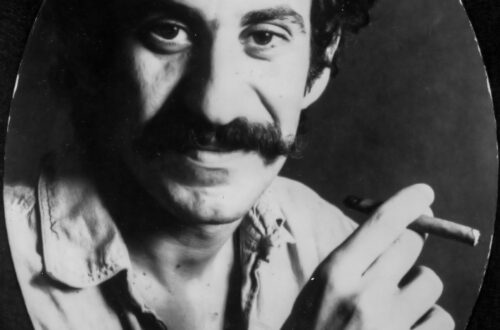-
Meet This Year’s Scholarship Winners: Marcella Finelli & William DiGiovanni
By Ray LaVerghetta, Scholarship Committee Chair
Every year the AMHS awards scholarships to two outstanding students who have demonstrated both academic excellence and a strong interest in Italian culture and the Italian language. As often happens, this year’s selection process was extremely challenging for the AMHS Scholarship Committee (Lucio D’Andrea, Peter Bell, Mark Lino, Ray LaVerghetta, Romeo Sabatini, and Lourdes Tinajero) because every candidate was deserving of a scholarship. Following weeks of review, the committee selected Marcella Finelli and William DiGiovanni as the academic year 2022-2023 scholarship winners.
Ms. Finelli is a rising senior at the University of Maryland, where she is double majoring in Italian and Education. Mr. DiGiovanni is a rising sophomore at Georgetown University. He is majoring in Italian and minoring in Biology. Both of these young, Italian-American university students are enthusiastic and passionate students of Italian who have cultivated strong ties to Italy and who illustrate, better than any words could, the extraordinary value of our Society’s scholarship program. We present below the letters in which the winners thank the AMHS for their awards and explain how important the scholarships are for their studies.
Thank You Letter from Marcella Finelli
Dear members of the Abruzzo and Molise Heritage Society,

I am extremely honored to have received one of the two AMHS scholarships for the 2022-2023 academic year.
This scholarship is a testament to my dedication to both the Italian language and culture. Growing up in an Italian-American household, with grandparents who immigrated to the U.S from Puglia, I have been exposed to and surrounded by Italian culture and language my entire life. I believe this sparked a passion in me to continue to explore Italian culture and language within a formal academic setting. Studying Italian for part of middle school, all four years of high school, and since I started at the University of Maryland has allowed me to expand my knowledge of Italian culture beyond what I had experienced myself at home and in our Italian-American community.
My studies of Italian have also granted me many opportunities I likely would not have had if I had not studied Italian in school. I have found work opportunities, made new friendships with individuals from all over the world, been able to study abroad in Perugia this semester, and explore and learn about new and interesting topics all taught in Italian.
Additionally, although I have always wanted to become a teacher, I wasn’t always sure about the content area I wanted to teach. My love of teaching and my love of language, especially Italian, propelled me to seek a double major in Education and Italian at UMD. It is often said to do what you love and love what you do. As time goes by I realize that I truly love teaching others to speak one of the most beautiful languages in the world and know that I am following my passion.
My studies are also a way to honor my family, in particular, my grandparents who, although they lived a good portion of their lives in the United States, continued to share their culture and language with us, passing along a love for a beautiful language and way of life.
Through the AMHS scholarship, I will be able to better focus on my studies and realize my dreams of spreading my love and passion for the Italian language and culture to others. I am incredibly grateful to have received this award and again, I would like to thank the members of the Abruzzo and Molise Heritage Society for selecting me for the 2022-2023 school year. I look forward to meeting the members at events upon my return to America.
Grazie mille, Marcella Finelli
Thank You Letter from William DiGiovanni
Dear Abruzzo and Molise Heritage Society,

I would like to express my sincere gratitude for the generous contribution of $4,000 that will be going towards my further undergraduate education. This scholarship will help me to continue exploring my Italian heritage and strengthening my connection with the language and culture. I am extremely grateful to have discovered the Abruzzo and Molise Heritage Society and their goal of preserving Italian heritage in the greater Washington, D.C. area.
My Italian heritage stems mostly from my father’s side of the family and traces back to Naples, whereas my mother’s side is Iranian. I was born in Providence, Rhode Island, and my Italian heritage played a very important role in my childhood. From a very young age, I attended Italian classes every Sunday in Providence with my three older brothers and mom. Afterwards, my family would spend the rest of the day in Federal Hill, a historic neighborhood in Providence rich with Italian-American heritage, culture, restaurants, and more. Holidays were always an opportunity to continue traditions with my extended family and strengthen my connection with Italian culture.
Ultimately, my family moved to Massachusetts where I was unable to find classes to continue learning Italian, and neither my middle nor high school offered Italian. As such, coming into college I was intent on re-learning Italian and exploring classes that focused on Italian history, writing, cinema, culture, and cuisine. I just completed my freshman year at Georgetown University, where I am majoring in Italian and am on the pre-medical track, with the aspiration of becoming an Orthopaedic Surgeon.
Being able to continue my studies of Italian and the further cultural education that comes with them is extremely meaningful and important to me. I cannot thank the Abruzzo and Molise Heritage Society enough for assisting me in doing so. After my upcoming sophomore year, I plan to study abroad for at least a semester (hopefully a year) in Naples, where I can be close to my family’s roots, or potentially Florence. I am extremely excited at the prospect of such an immersion into Italian culture and language.
Thank you so much again for the generosity and possibilities that this scholarship will provide me with. I hope to one day be able to give back to the Abruzzo and Molise Heritage Society and Italian Americans when I am older so they can have such vital opportunities as this one.
My sincerest regards,
William DiGiovanni
.
July/August 2022
-
Siamo Una Famiglia

D’Andrea-Pitassi Family Wedding in Pittsburgh
On May 14, 2022, several family members of AMHS President Emeritus Lucio D’Andrea and his wife Edvige traveled to Pittsburgh, Pa., for the wedding of Andrew DeSalle and Lauren Laskos. Andrew is the son of Rosanna DeSalle, a cousin to AMHS Immediate Past President Maria D’Andrea-Yothers. The wedding reception was attended by over 200 guests, many of whom are related to Edvige (Pitassi) D’Andrea, who is the sole surviving matriarch of the Pitassi family. It was a most festive event — a cause for joy and celebration after two-plus years of the pandemic.

The D’Andrea-Pitassi family.
Credit: Courtesy of Leda HeidenrichA Milestone Birthday
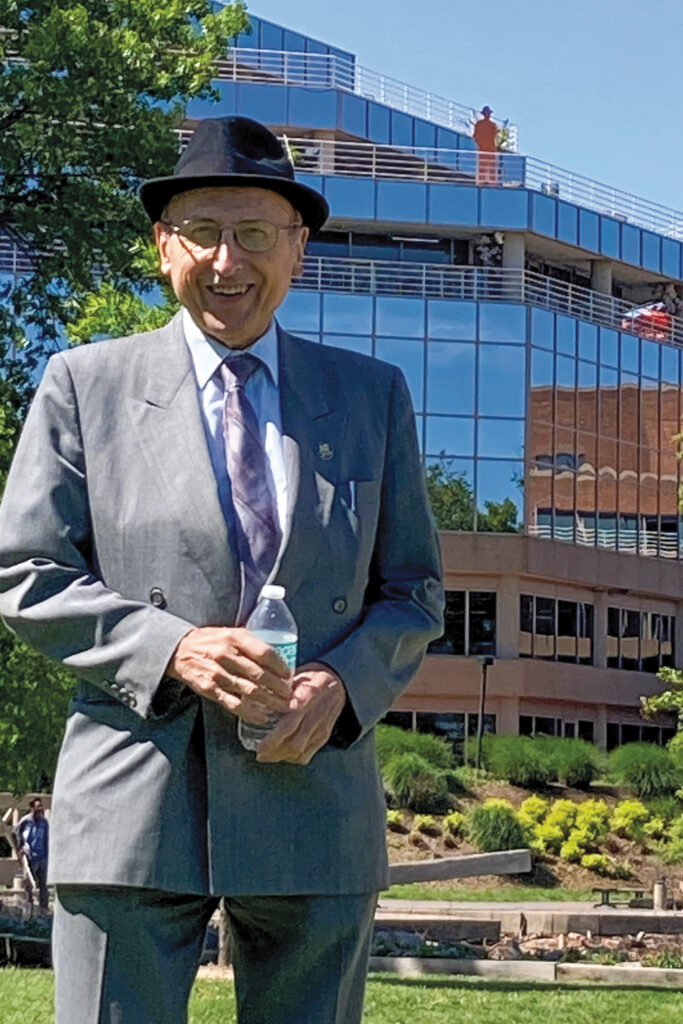
AMHS Board Member Joseph “Sonny” Scafetta, Jr., celebrated his 75th birthday on May 10, 2022. Sonny is pictured here in Oronoco Bay Park in Alexandria, Va., in front of the building where is law office is located.
Credit: Patrick Colin FarrellWedding Bells
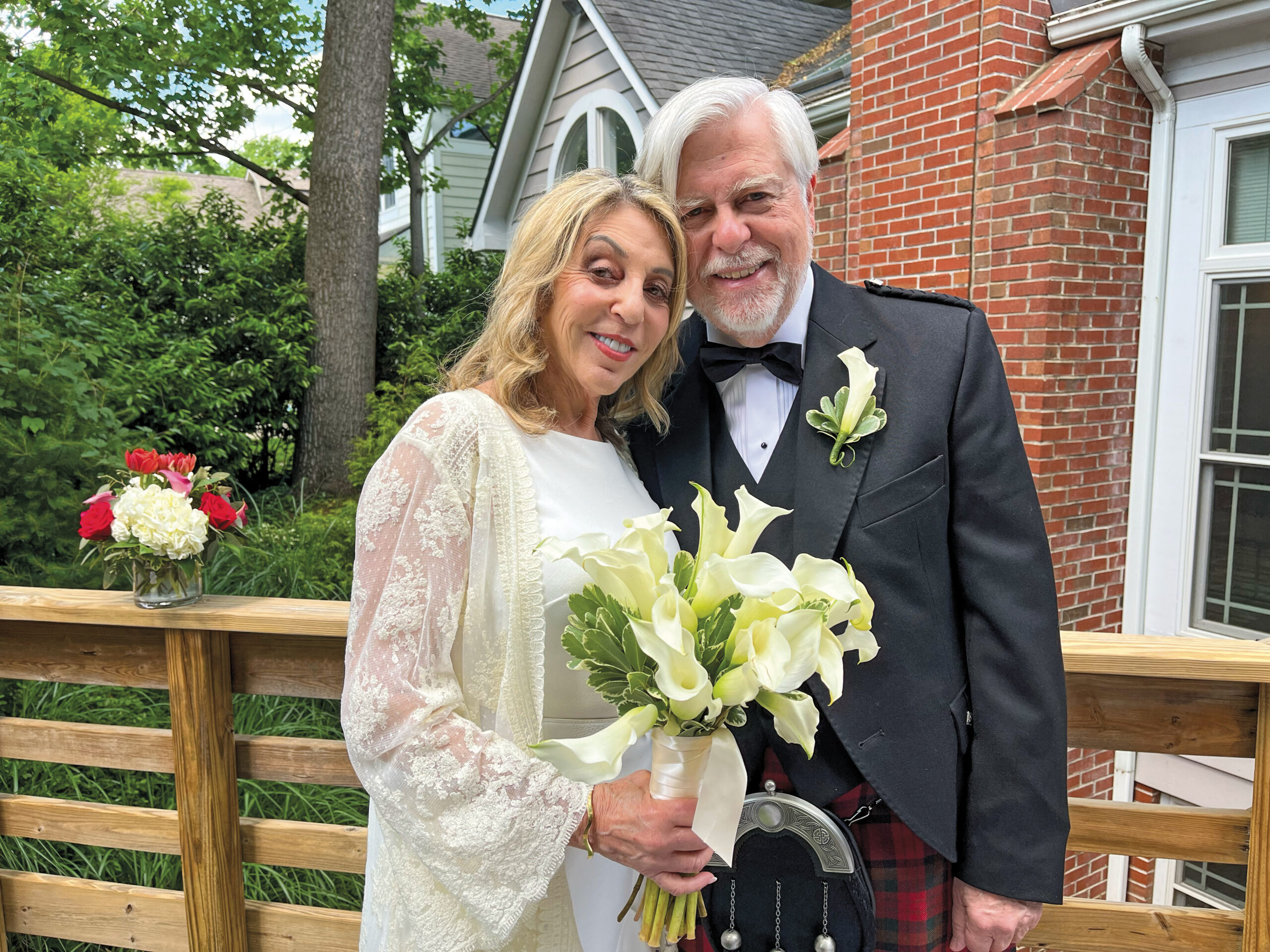
Ruth Bergman and Carmine Spellane on their wedding day.
Credit: Wendy DouglasAMHS Members Carmine James Spellane and Ruth Bergman were married on May 29, 2022. The outdoor ceremony took place at the home of Ruth’s son, Alon Orstein and his family, in North Chevy Chase, Md. Carmine’s son, Aron Spellane, was the officiant. The couple resides in the Friendship Heights neighborhood of Chevy Chase, Md. Carmine is also the Secretary of the AMHS and editor of the Notiziario.
Congratulations, Joey
AMHS member, Joseph Anthony Scafetta III, received his Bachelor of Science diploma from Marymount University on May 14, 2022. He was enrolled in a five-year, dual-degree program in math and information technology. Joey is the son of AMHS Member Joseph “Sonny” Scafetta, Jr. and Teresa Scafetta. Sonny is also a member of the AMHS Board of Directors.
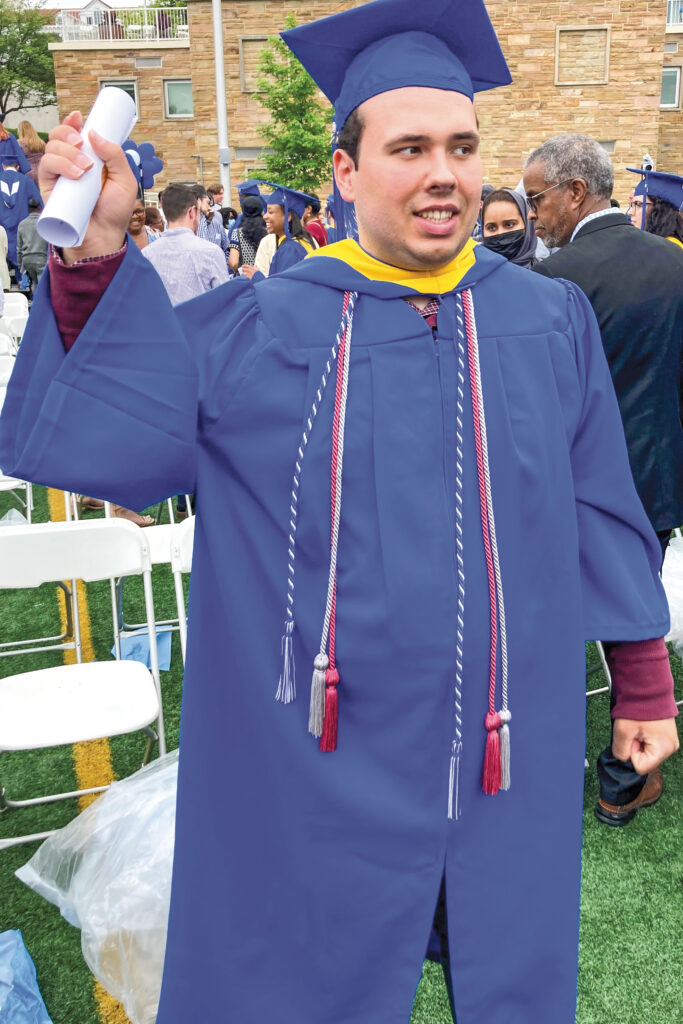
Joseph Scafetta III celebrates his graduation.
Credit: Patrick Colin FarellAMHS Membership
New Members William DiGiovanni, Marcella Finelli, Eugene Robert Giammittorio, and Mary Ann Re. Birthdays Compleanni a Luglio
Gilber Misantonio, July 3; Julia Paola, July 7; Dianne Francesconi Lyon, July 6; Michael De March, July 9; Susan Baldassari, July 10; Raymond Bernero, July 12; David Ciummo, July 13; Anthony D’Onofrio, July 15; Ilaria Pirocchi, July 17; Brian Corbin, July 18; Crystal Hovermale, Matthew DiFiore, and Roberto Severino, July 19; Mario Ciccone, July 21; Mary Smargiassi Muth, July 22; Lina Pronio, July 23; and Lynn Sorbara and Robert O’Malley, July 27.Compleanni ad Agosto
Mario Marinucci, August 2; Ray LaVerghetta, August 5; Pietro Masci and Mark Anthony Evans, August 8; Ray Abruzzo and Domenico Cipicchio, August 12; Nancy DeSanti and Susan Di Blasio, August 15; Joseph Ruzzi, Sr. and Karen Grasso, August 16; Rose Ruzzi, August 18; Angela Campanella, August 21; Robert Lucian, John Joseph D’Amico, and Joseph Novello, August 23; and Donna Caruso, August 30.Anniversaries Anniversari a Luglio
Joseph & Joann Novello and Joseph “Sonny” & Teresa Scafetta, July 4; Berardino Palazzo & Ilaria Pirocchi, July 10; Joseph & Susan Di Blasio, July 13; Robert & Barbara Verdile, July 17; Renato & Rita Orcino, July 19; Greg & Diane Bernabei, July 21; Brian Corbin & Donna DeBlasio, July 25; Stephan & Rita Carrier and David Ciummo & Sabrina De Sousa, July 31.Anniversari ad Agosto
Joseph & Pam Lupo, August 5; Corrado Dal Forno & Julie Finigan-Dal Forno, August 7; Jeffrey Clark & Macarena Fernadez, August 15; Domenico & Julia Conti, August 19; and Guy & Donna Caruso, August 26.Membership Information Category # of Persons
Associate (Couple): 5 x 2 = 10
Associate (Individual): 43
General (Couple): 49 x 2 = 98
General (Individual): 92
Honorary: 11
Scholarship: 2
Student: 7
Total Membership: 263July/August 2022
-
Fontecchio

By Nancy DeSanti
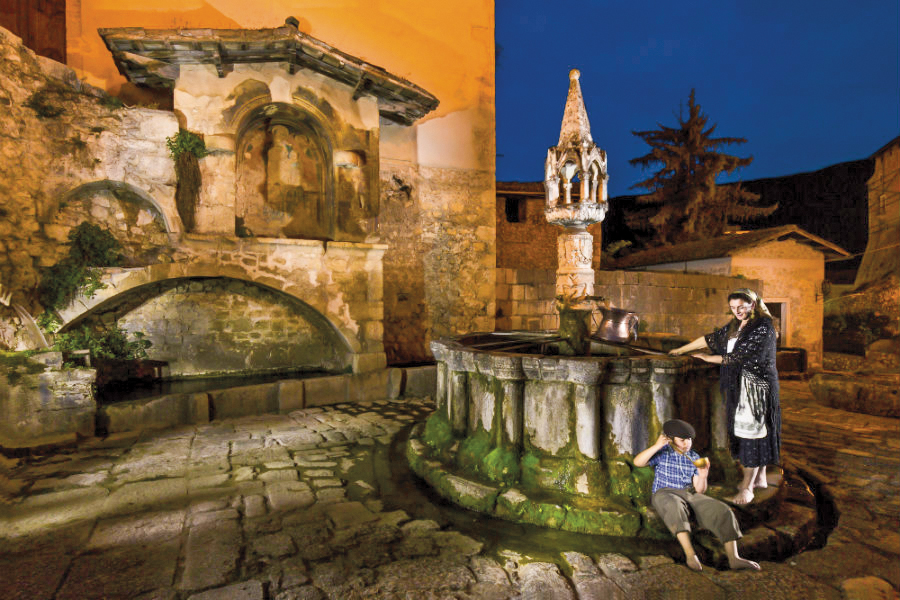
Evening in Fontecchio.
Credit: Giorgio MarcoaldiProvince of L’Aquila, Region of Abruzzo
The small medieval town of Fontecchio is located in the province of L’Aquila within the Monte Sirente community and the Sirente-Velino Regional Park. It has approximately 401 inhabitants, known as Fontecchiani or Fonticulani.
There is archaeological evidence of the Roman settlement of Fonticulanum down on the Aterno River. In the Middle Ages, a castle was built on top of the hill and the population moved up there.
Today, visitors can see a wonderful and well-preserved historical center. At the sites called Il Castellone and Monte San Pio, pre-Roman constructions were found, and inside the town itself there are Roman remains. The medieval settlement arose in the 11th century from the union of five hamlets (vici), including Fons Tichiae. In 1648, the town was besieged and destroyed during a period of 50 days.
Fontecchio’s historic center preserves the characteristic of a fortified medieval village, with access doors, sections of high walls, towers and majestic palaces, among which stands the mighty fortified palace of the Barons Corvi, from which, according to an ancient tradition, the Marquise Corvi put an end to the long siege by the army of Braccio da Montone by killing the leaders of the assailants with a sledgehammer.
To commemorate the siege, every evening the Clock Tower (Torre dell’Orologio) beats 50 times, as many as the days of the siege, thus mixing history, legend and tradition. The clock, considered one of the oldest in Italy, moves the single hand based on a perfect mechanism of weightsand beats the “Italian hours,” that is, the dial is divided into six hours and the mechanism moves only the hour hand.
Among the many, still very visible, Roman architectural remains are the base of a temple dedicated to Jupiter where the Church of Santa Maria della Vittoria was built. The brick flooring is arranged in a herringbone fashion behind the apse of the church.
Fontecchio was severely damaged by an earthquake in L’Aquila in 1703, and later also from the L’Aquila earthquake of 2009. After the major earthquake in 2009,half of the town’s homes were condemned as unsafe. The tower hosts a permanent photographic exhibition on the places in L’Aquila before and after the 2009 earthquake.
Today, though, Fontecchio is buzzing with construction and activity, and has become a hub for international artists.
What to See
- Clock Tower
- Fonte Trecentesca
- Convent of San Francesco
- Church of Santa Maria della Pace
- Church of Madonna delle Grazie
- Church of Santa Maria della Vittoria
- The Piazza del Popolo with an artistic, unique 14th-century fountain
- Church of St. Francis with a fine Romanesque portal
Important Dates
- February 3 – Feast of St. Blaise, the patron saint
- Summer – “Paese in Arte” Festival, featuring several cultural events.
Italiano
Fontecchio

Tradotto da Ennio Di Tullio
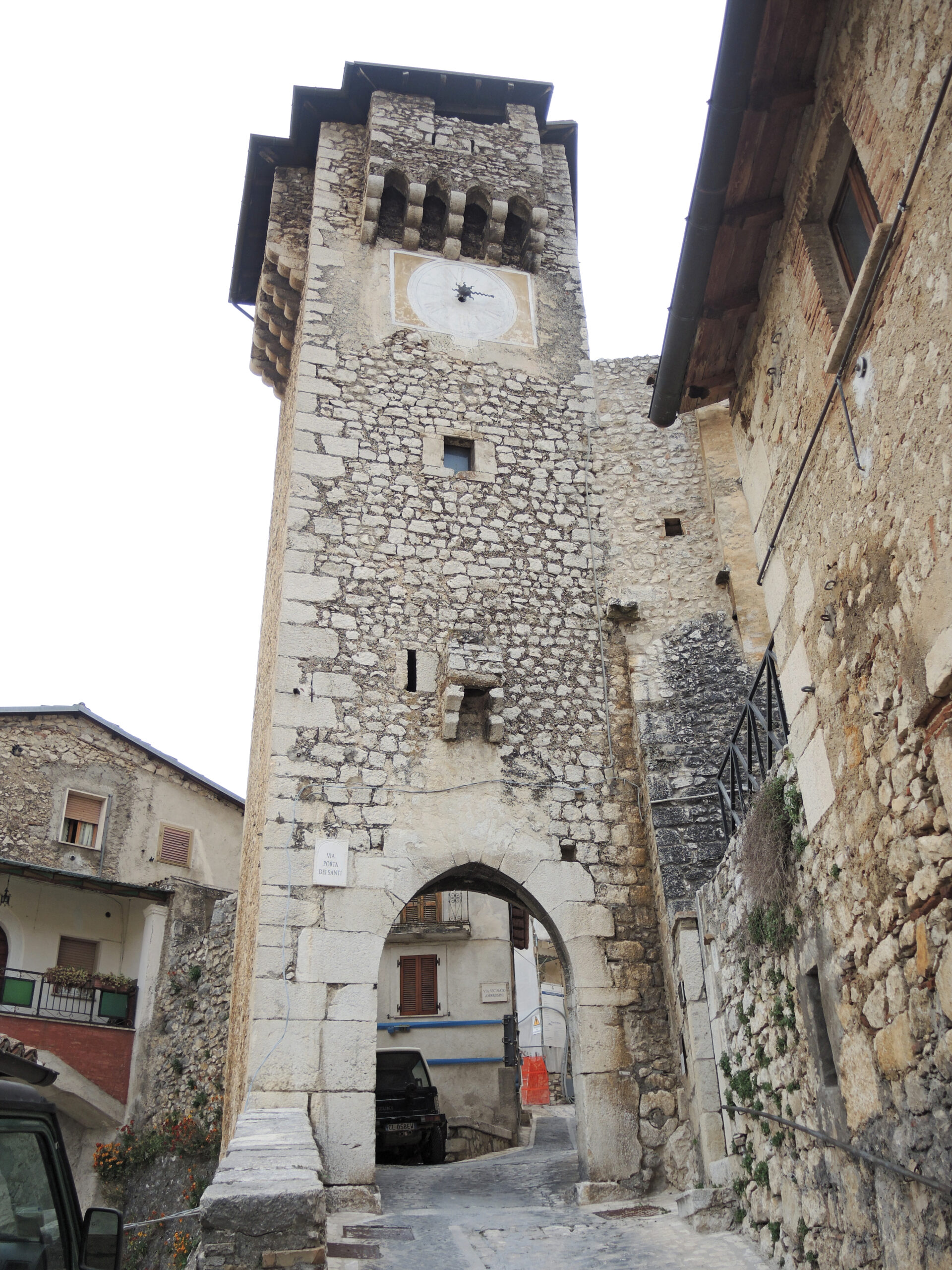
La Torre dell’Orologio.
Credit: WikipediaProvincia di L’Aquila, Regione Abruzzo
Il piccolo borgo medievale di Fontecchio si trova in provincia dell’Aquila all’interno della comunità del Monte Sirente e del Parco Regionale Sirente-Velino. Conta circa 401 abitanti, detti Fontecchiani o Fonticulani.
Esistono testimonianze archeologiche dell’insediamento romano di Fonticulanum sul fiume Aterno. In epoca medioevale venne costruito un castello sulla sommità del colle e la popolazione vi si trasferì.
Oggi i visitatori possono vedere un centro storico meraviglioso e ben conservato. Nei siti denominati Il Castellone e Monte San Pio sono state rinvenute costruzioni preromane e all’interno del paese stesso sono presenti resti romani. L’insediamento medievale sorse nell’XI secolo dall’unione di cinque frazioni (vici), tra cui Fons Tichiae. Nel 1648 la città fu assediata e distrutta per un periodo di 50 giorni.
Il suo centro storico conserva la caratteristica di borgo medievale fortificato, con porte di accesso, tratti di alte mura, torri e palazzi maestosi, tra i quali spicca il poderoso palazzo fortificato dei Baroni Corvi, da cui, secondo un’antica tradizione, la Marchesa Corvi pose fine al lungo assedio dell’esercito di Braccio da Montone, uccidendo con una mazza i capi degli assalitori.
Per commemorare l’assedio, ogni sera la Torre dell’Orologio (Torre dell’Orologio) batte 50 volte, tanti quanti i giorni dell’assedio, mescolando così storia, leggenda e tradizione. L’orologio, considerato uno dei più antichi d’Italia, muove la sola lancetta basata su un perfetto meccanismo di pesi e batte le “ore italiane”, cioè il quadrante è diviso in sei ore e il meccanismo muove solo la lancetta delle ore.
Tra i tanti resti architettonici romani ancora ben visibili vi è il basamento di un tempio dedicato a Giove dove fu edificata la Chiesa di Santa Maria della Vittoria. Il pavimento in laterizio è disposto a spina di pesce dietro l’abside della chiesa.
Fontecchio è stata gravemente danneggiata dal terremoto dell’Aquila nel 1703, e successivamente anche dal terremoto dell’Aquila del 2009. Dopo il forte terremoto del 2009, metà delle abitazioni del paese sono state condannate come pericolanti. La torre ospita una mostra fotografica permanente sui luoghi dell’Aquila prima e dopo il terremoto del 2009.
Oggi, però, Fontecchio brulica di costruzioni e attività, ed è diventata un hub per artisti internazionali.
Le attrazioni del luogo:
- Torre dell’orologio
- Fonte Trecentesca
- Convento di San Francesco
- Chiesa di Santa Maria della Pace
- Chiesa della Madonna delle Grazie
- Chiesa di Santa Maria della Vittoria
- La Piazza del Popolo con una fontana artistica e unica del 14° secolo
- Chiesa di San Francesco con bel portale romanico
Date da ricordare:
- Febbraio – Festa di San Biagio, patrono
- Estate – Festival “Paese in Arte”, caratterizzato da numerosi eventi culturali.
Sources: https://en.wikipedia.org/wiki/Fontecchio
https://www.italyheritage.com/regions/abruzzo/laquila/fontecchio.htm
https://www.e-borghi.com/en/village/L’Aquila/328/fontecchioIssue Date
-
Trivento

By Nancy DeSanti
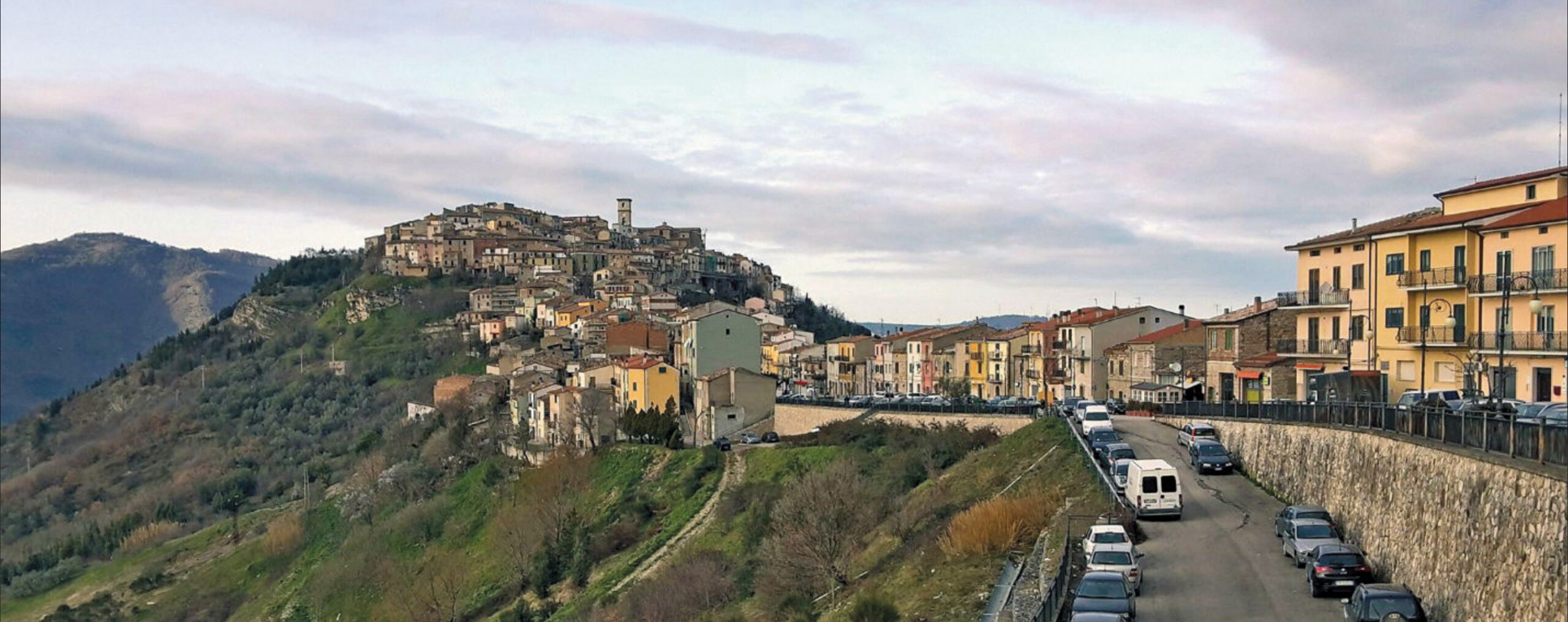
The view approaching Trivento.
Credit: Trivento | Marco Pirulli
Province of Campobasso, Region of Molise
The town of Trivento is located on the border with Abruzzo in the Trigno Valley, perched on a hill about 25 kilometers northwest of Campobasso. It has approximately 4,663 inhabitants, known as Trevintini. It is surrounded by territory dotted with larch woods, oak groves and rock formations called morge, part of the Parco delle Morge Cenozoiche del Molise.
One of the larger towns in Molise, Trivento rises on a rocky spur dominating the surrounding plains and hills from where it is possible to enjoy a magnificent view, from the southern coast of Abruzzo down to the Gargano and Tremiti islands.
Its church of Sts. Nazario, Celso e Vittore is the cathedral called the Episcopal See of the Roman Catholic Diocese of Trivento. It was built with re-used Roman stones and column capitals on a pagan altar possibly dedicated to the goddess Diana. In early Christian times, a crypt was built on the spot in honor of San Casto, the first bishop of Trivento who started to convert the local Samnite population to Christianity. Most of the architecture is typical Romanesque.
The Trivento name refers to the geographical position of the village in Molise, exposed to winds from the east, south and north. An inscription in a Roman stone found in the cathedral crypt showed that the ancient name was Terventi. An important center of the Samnites, it was destroyed during the 3rd century wars of the Samnites against Rome, and the Romans repopulated it with the Voltinia tribe.
Under the Normans, the fiefdom of Trivento was ruled by numerous seigniories, including the Caldara and the Angevin, which followed one another in occupying the Ducal Castle dating back to the 13th century. The Ducal Castle has high walls, with an irregular plan, and two main entrances. The interior has been modified over the centuries, and the underground part is spartan because it was used in the past as a prison while the piano nobile preserves a hall with frescoes.
In recent decades in the surrounding countryside, there have been over 50 farms, an impressive growth of biological agriculture (farro, olives, cereals), which should have a great future in Molise whose soil is almost unexploited due to the very low population density, and unpolluted, thanks to the lack of industrial development.
Trivento is known for its long staircase, the Scalinata di San Nicola (St Nicholas’ Staircase) with 365 steps, one for each day of the year. The Scalinata di San Nicola is the symbol of the town and was built in three lanes of white limestone. The 365 steps connect the lower part of the village to the upper part called Piano.
Along the slope of the staircase are craft shops displaying crochet work, one of Trivento’s typical features. Beginning in 2018, Lucia Santorelli, in collaboration with the whole town, created a crocheted carpet so long that it covered the entire San Nicola staircase. This charitable initiative aroused worldwide interest. During Advent of the same year, a large Christmas tree made of hundreds of crocheted doilies was erected in Trivento’s Piazza Fontana, making it look like a colorful mosaic.
For this reason, Trivento is now considered the Crochet Capital. In 2019, Trivento hosted the first edition of the Yarn Bombing Day event. Artists and crochet enthusiasts from all over the world came to Trivento to make their crochet crafts. Each item was then exhibited in a path that led from Piazza Fontana to the heart of the historic center.
One of the best times to visit Trivento may be in September, during the Sagra dello zapp’ttone e dei cavatelli. These are two typical Trivento dishes, the first based on lamb livers and veal tripe, while the second is the classic fresh pasta served with broccoli or cardoncelli mushrooms.
What to See
- Scalinata di San Nicola
- The Palazzo Colaneri near the cathedral, a typical Renaissance mansion.
- The Cathedral of SS. Nazario, Celso and Vittore, with a baptismal fountain of the 4th century and a crypt to San Casto, Martyr.
Important Dates
- July 28 – Feast of St. Nazario, the patron saint
- September – Sagra dello zapp’ttone e dei cavatelli
Italiano
Trivento

Tradotto da Ennio Di Tullio
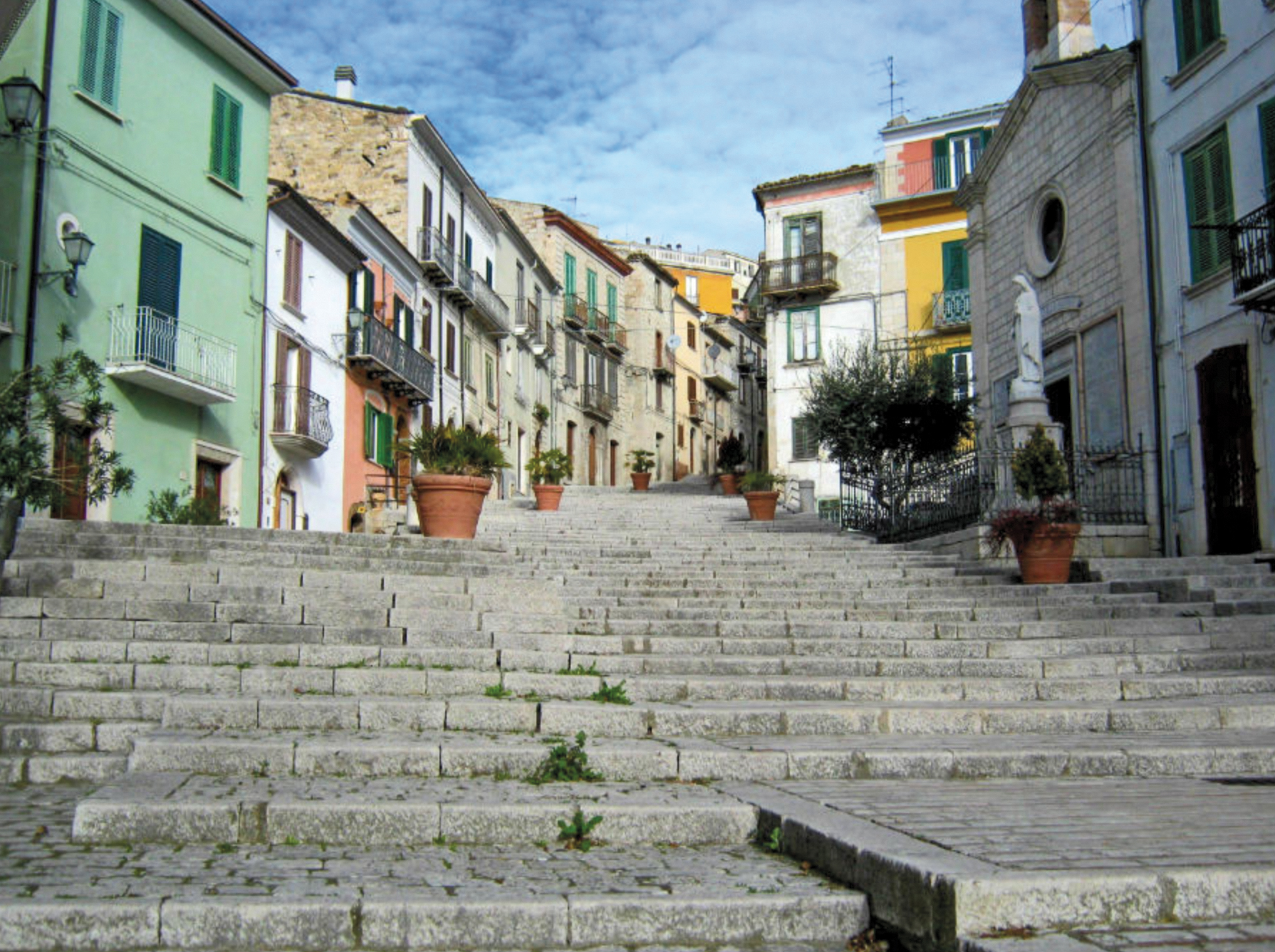
La Scalinata di San Nicola.
Credit: Trivento | Pro Loco TerventumProvincia di Campobasso, Regione Molise
Il comune di Trivento si trova al confine con l’Abruzzo nella Valle del Trigno, arroccato su un colle a circa 25 chilometri a nord ovest di Campobasso. Conta circa 4.663 abitanti, conosciuti come Trevintini. È circondato da un territorio costellato di boschi di larici, querceti e formazioni rocciose dette morge, facenti parte del Parco delle Morge Cenozoiche del Molise.
Tra i centri più grandi del Molise, Trivento sorge su uno sperone roccioso che domina la pianura e le colline circostanti da dove è possibile godere di un magnifico panorama, dalla costa meridionale dell’Abruzzo fino al Gargano e alle Isole Tremiti.
La sua chiesa dei SS. Nazario, Celso e Vittore è la sede vescovile della cattedrale della diocesi cattolica di Trivento. Fu costruito con pietre romane di riutilizzo e capitelli di colonne, su un altare pagano forse dedicato alla dea Diana. Poi in epoca paleocristiana sul posto fu costruita una cripta in onore di San Casto, primo vescovo di Trivento che iniziò a convertire al cristianesimo la popolazione sannita locale. La maggior parte dell’architettura è tipicamente romanica.
Il nome Trivento si riferisce alla posizione geografica del paese molisano, esposto ai venti provenienti da est, sud e nord. Un’iscrizione in una pietra romana rinvenuta nella cripta della cattedrale mostrava che l’antico nome era Terventi. Importante centro dei Sanniti, fu distrutto durante le guerre dei Sanniti contro Roma del III secolo, e i Romani lo ripopolarono con la tribù Voltinia.
Sotto i Normanni il feudo di Trivento fu retto da numerose signorie, tra cui i Caldara e gli Angioini, che si susseguirono occupando il Castello Ducale risalente al XIII secolo. Il Castello Ducale presenta alte mura, a pianta irregolare, e due ingressi principali. L’interno è stato modificato nel corso dei secoli, e la parte sotterranea è spartana perché usata in passato come prigione mentre il piano nobile conserva un salone affrescato.
Negli ultimi decenni nelle campagne circostanti si sono registrate oltre 50 aziende agricole, una crescita impressionante dell’agricoltura biologica (farro, olivo, cereali), che dovrebbe avere un grande futuro in Molise il cui suolo è quasi inutilizzato per la bassissima densità abitativa, e incontaminata, grazie al mancato di sviluppo industriale.
Trivento è noto per la sua lunga scalinata, La Scalinata di San Nicola, con 365 gradini, un gradino per tutti i giorni dell’anno (365). La Scalinata di San Nicola è il simbolo del Trivento ed è stata costruita su tre corsie di calcare bianco. I 365 gradini collegano la parte bassa del paese alla parte alta denominata Piano.
Lungo il pendio della scalinata si trovano botteghe artigiane che espongono il lavoro all’uncinetto, una delle caratteristiche tipiche del Trivento. A partire dal 2018 Lucia Santorelli, in collaborazione con tutto il comune, ha realizzato un tappeto all’uncinetto così lungo da coprire l’intera scalinata di San Nicola. Questa iniziativa di beneficenza ha suscitato interesse in tutto il mondo. Durante l’Avvento dello stesso anno, in Piazza Fontana del Trivento, fu eretto un grande albero di Natale composto da centinaia di centrini all’uncinetto, che sembrava un mosaico colorato.
Per questo Trivento è ormai considerata la Capitale dell’Uncinetto. Nel 2019 Trivento ha ospitato la prima edizione dell’evento Yarn Bombing Day. Artisti e appassionati di uncinetto da tutto il mondo sono venuti a Trivento per realizzare i loro lavori all’uncinetto. Ogni pezzo è stato poi esposto in un percorso che da piazza Fontana portava nel cuore del centro storico.
Uno dei periodi migliori per visitare Trivento potrebbe essere settembre, durante la Sagra dello zapp’ttone e dei cavatelli. Si tratta di due piatti tipici del Trivento, il primo a base di fegatini di agnello e trippa di vitello, mentre il secondo è la classica pasta fresca servita con broccoli o funghi cardoncelli.
Le attrazioni del luogo:
- Scalinata di San Nicola
- Il Palazzo Colaneri vicino alla cattedrale, tipico palazzo rinascimentale.
- La Cattedrale dei SS. Nazario, Celso e Vittore, con una fontana battesimale del IV secolo e una cripta a San Casto, Martire.
Date da ricordare:
- 28 luglio – Festa di San Nazario, patrono
- Settembre – Sagra dello zapp’ttone e dei cavatelli
Sources: https://en.wikipedia.org/wiki/Trivento
https://www.italyheritage.com/regions/molise/province-campobasso/trivento.htm
https://www.e-borghi.com/en/village/Campobasso/317/triventoJuly/August 2022
-
Join AMHS for The Ferragosto Picnic on Sunday, August 14, 2022
By Maria D’Andrea-Yothers

. The AMHS will be returning to Fort Ward Park in Alexandria, Va., for this year’s Ferragosto Picnic, Sunday, August 14, 2022, from 3:00 p.m. – 7:00 p.m. We have reserved Area 5 (not the covered pavilion), which has 9 large picnic tables, two grills, and plenty of parking.
The event is free and open to all, rain or shine. As in prior years, AMHS will provide beverages (soft drinks, water, wine, and beer which, according to our ABC license, can only be drunk from kegs in plastic cups). We ask members, friends and family to bring a basket of food to share, paper products and utensils, and Italian cards. You may also want to bring lawn chairs and a personal portable grill, so long as it is charcoal only. Bring your bocce sets too — while there is no “official” bocce court, we can make our own. We hope you will bring your family and friends to join the afternoon of fun and friendship. For additional details, please see AMHS Annual Ferragosto Picnic (abruzzomoliseheritagesociety.org)
July/August 2022


